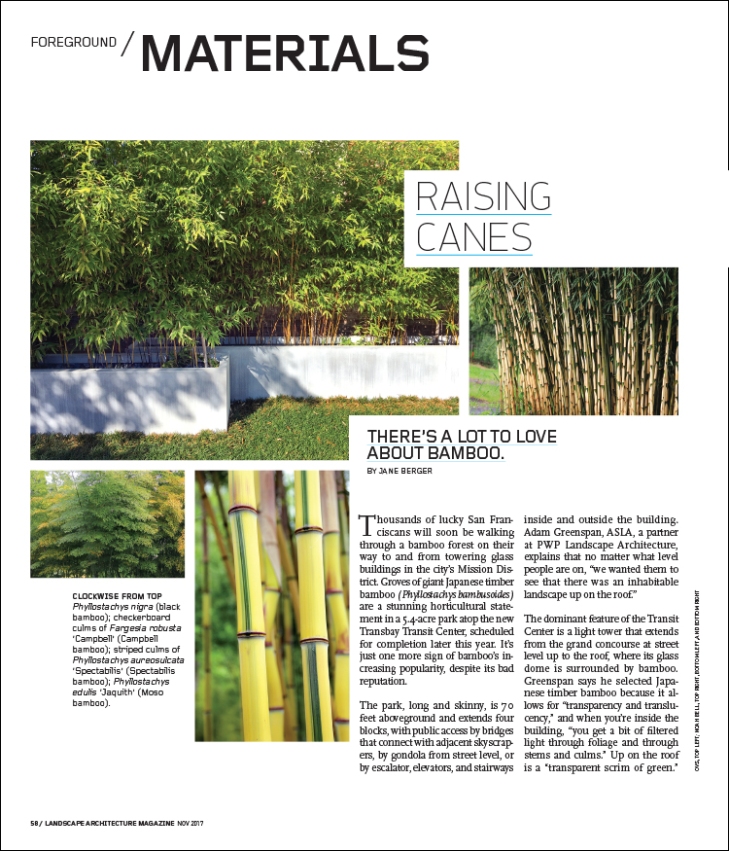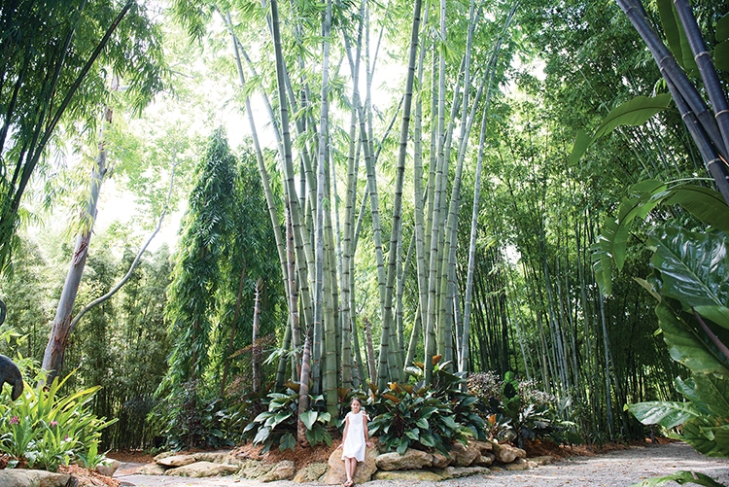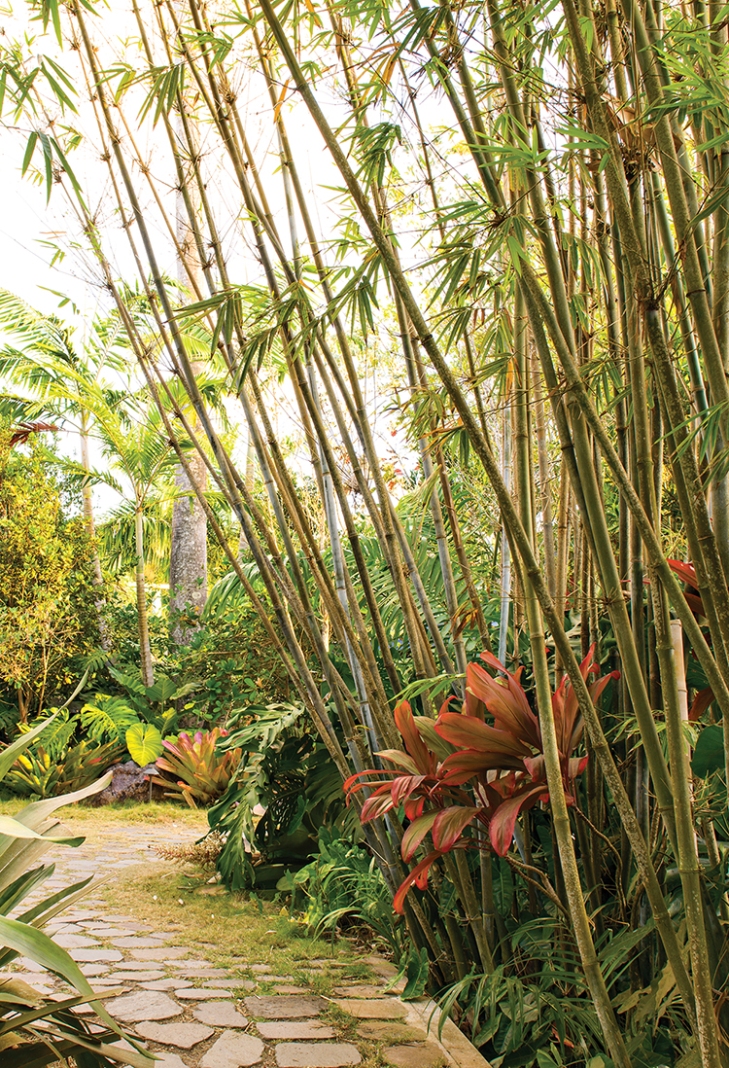BY JANE BERGER

There’s a lot to love about bamboo.
FROM THE NOVEMBER 2017 ISSUE OF LANDSCAPE ARCHITECTURE MAGAZINE.
Thousands of lucky San Franciscans will soon be walking through a bamboo forest on their way to and from towering glass buildings in the city’s Mission District. Groves of giant Japanese timber bamboo (Phyllostachys bambusoides) are a stunning horticultural statement in a 5.4-acre park atop the new Transbay Transit Center, scheduled for completion later this year. It’s just one more sign of bamboo’s increasing popularity, despite its bad reputation.
The park, long and skinny, is 70 feet aboveground and extends four blocks, with public access by bridges that connect with adjacent skyscrapers, by gondola from street level, or by escalator, elevators, and stairways inside and outside the building. Adam Greenspan, ASLA, a partner at PWP Landscape Architecture, explains that no matter what level people are on, “we wanted them to see that there was an inhabitable landscape up on the roof.”
The dominant feature of the Transit Center is a light tower that extends from the grand concourse at street level up to the roof, where its glass dome is surrounded by bamboo. Greenspan says he selected Japanese timber bamboo because it allows for “transparency and translucency,” and when you’re inside the building, “you get a bit of filtered light through foliage and through stems and culms.” Up on the roof is a “transparent scrim of green.” The bamboo is planted in a concrete basin about four feet deep, which sequesters the bamboo’s rhizomes so they cannot stray.
Phyllostachys is one of the “running” bamboos that can be invasive, and it’s at the heart of the phobia about them. It’s often planted to screen out neighboring views, but unless it’s properly contained, it spreads aggressively and sometimes even breaks up concrete driveways. Eric Groft, FASLA, principal at Oehme, van Sweden (OvS), says, “Bamboo strikes fear in everyone, as soon as you say the word. But there is bamboo, and there is bamboo.”

Partial elevation of San Francisco’s Transbay Transit Center roof garden with a grove of Japanese timber bamboo. Image courtesy of PWP Landscape Architecture.
There are more than 1,600 species of bamboo worldwide, temperates and tropicals, clumpers and runners. Some bamboos tolerate winters as far north as USDA Zone 4; others thrive in the heat and humidity of USDA Zone 8 and higher. The clumpers spread slowly in a radial fashion and are not considered problematic. The runners spread by sending out rhizomes and, depending on the species, spread slowly or very quickly.
A number of municipalities have banned running bamboo, but growers and designers think that’s a mistake. Noah Bell, the manager of Bamboo Garden nursery in North Plains, Oregon, says people tend to think of bamboo as one single plant, but different species behave in vastly different ways. Most of the runners are temperate bamboos, and the ones people fear most include Phyllostachys, Sasa, Shibataea, Pseudosasa, and Pleioblastus. Bell says running bamboos can easily be contained with a biannual maintenance program of pruning or mowing. Groft of OvS says “blatantly banning the plant” simply doesn’t work: “Nature’s going to win, no matter how much you try to legislate.”
For evergreen screening in small gardens, OvS sometimes uses Phyllostachys in stainless steel containers, and they planted a slower running Sasa ground-cover bamboo on a new project in Sagaponack, New York. “If there’s a qualified landscape architect on the project who can use it with control or respect, that’s the critical thing,” Groft says.
At OvS, Fargesia, the most cold-hardy of the clumpers, has been a go-to specimen since the firm’s inception. The late Wolfgang Oehme brought Blue Fountain bamboo (Fargesia nitida) to the United States from Germany in the 1950s. With a beautiful bluish hue and arching habit, it was Oehme’s favorite plant, often used as a focal point outside a window, and it soon took off among designers. But F. nitida is now in the midst of its 100-year gregarious flowering cycle, which means that all bamboos of a specific species—no matter where—flower, produce seed, and die.
OvS now designs with a slightly smaller bamboo, F. rufa, the toughest of the cold-hardy clumpers. Bamboo Garden in Oregon has collected seed from F. nitida and cultivated new plants, but Bell is watching for unique characteristics to emerge from the 100 or so plants they’ve propagated thus far. In the meantime, he’s promoting F. robusta ‘Campbell,’ a new, rare species that has checkerboard white and dark green culms, and Fargesia sp. ‘Jiuzhaigou,’ which has a feathery, delicate leaf and culms. Its branches turn bright cherry red at certain times of the year.
Beyond the urban landscape, there are vast possibilities for bamboo, says Susanne Lucas, president of the American Bamboo Society and CEO of the World Bamboo Organization. Lucas notes that bamboos range from low ground covers just a foot or so high to tall timber varieties used for construction.

Dendrocalamus giganteus (giant bamboo), a tropical clumper. Photo by Shea Christine Photography.
Bamboo is a grass, one of the fastest-growing plants on Earth. Some species sprout up as much as one meter daily. Animals shelter from predators among its woody stems. Humans fashion myriad items from bamboo canes: fishing poles, chopsticks, skewers, flutes, rafts, even textiles. Large timber bamboos are processed for textiles, flooring, furniture, plywood, bridges, blinds, and scaffolding. They have the same tensile strength as steel and a compressive strength greater than concrete.
Bamboo is a renewable resource, regenerating when harvested and maturing within three to four years. It absorbs carbon at four times the rate of hardwood trees and produces up to 35 percent more oxygen. Lucas says there are large industrial investigations under way in terms of carbon trading and establishing plantations on degraded lands. She is particularly enthusiastic about the three bamboos native to the United States, all of the genus Arundinaria, or cane, which in precolonial times covered thousands of acres in South Carolina, Kentucky, Tennessee, and south to Arkansas. The native bamboos could be used for roadside reclamation and purification of contaminated soils, she suggests, and they would also be great for wildlife.
In tropical zones, Lucas says, there are “phenomenal bamboos.” Raymond Jungles, FASLA, would agree. He used more than 20 varieties of tropical clumpers at the Golden Rock Inn on the West Indies island of Nevis. “Bamboos make a special statement in a garden, giving movement and sound, shadow, and grace,” he says. Among his favorites are some of the big timber bamboos that create a forestlike effect and have “colorful new shoots when new canes are forming.” Jungles plants bamboo for privacy screens, wind barriers, erosion control, and as specimens. “Some bamboo is good to block things out in the background and fill space,” he notes, and others are used simply “to walk under and enjoy the different characteristics of the canes.”
Greenspan of PWP Landscape Architecture likes Mexican weeping bamboo (Otatea acuminata ssp. aztecorum) and its fine-textured leaves. He says it’s “soft-looking, almost like a weeping willow.” Tropical blue bamboo (Bambusa chungii) is another favorite, often used as a focal point. It’s a 30-foot-high bamboo, and its two-inch culms are a steely blue. “It has a very delicate look,” he says, “but it’s the powdery blue colored stems which are really amazing.”
Robert Saporito, the owner of Tropical Bamboo Nursery & Gardens in Loxahatchee, Florida, says that following a series of hurricanes, Floridians discovered that bamboos are flexible and very durable in storms. After the state’s real estate boom led to vertical building—homes of three stories or more—people are looking for privacy. “The only real solution is bamboo,” he says. Saporito’s website notes that most of the tropical bamboo species he carries are somewhat new to the United States, and many of the most desirable species have been here only a few years.
Both Saporito and Noah Bell of Bamboo Garden believe bamboo is growing in popularity among homeowners, landscape architects, and designers. As Bell puts it, “It’s something new to experiment with, it has an interesting modern look to it, and it’s become a symbol of sustainability and abundance.”

Bambusa chungii (tropical blue bamboo) is a favorite of Raymond Jungles, FASLA. Image courtesy of Raymond Jungles, Inc.
Some landscape architects have long been aware of bamboo’s positive attributes. Twenty years ago, Michael Van Valkenburgh Associates, Inc. (MVVA) installed a number of bamboos in the Vera List Courtyard at the New School for Social Research in New York City. Principal Laura Solano, ASLA, explains that Van Valkenburgh, “such a plants person,” wanted to make a “first foray into bamboo.” They brought in the American Bamboo Society’s Susanne Lucas as a consultant, and she was able to deliver the unexpected: Among the bamboos at the New School are dwarf fernleaf bamboo (Pleioblastus distichus), a tough ground cover with fern or palmlike leaves; kuma bamboo grass (Sasa veitchii), a taller ground cover that has long, fat leaves of dark green with pure white edges; and umbrella bamboo (Fargesia murielae), with light blue new shoots and a soft, umbrellalike canopy of evergreen leaves.
MVVA is not in the least bit reluctant to plant running bamboos. Solano says more education is needed so that bamboo is not mindlessly branded as invasive. The city “is a terrific place for bamboo because it thrives in so many tough conditions, and it’s perfectly happy to be constrained by an overabundance of pavement.”
Solano is also partial to bamboo because of the way it looks. “It can supercharge the way that a garden or landscape feels,” she explains. “Nothing moves quite as beautifully in the wind as tall bamboo culms or as amusingly as the bouncy branches on clumping bamboo stands of some Fargesia species.”
Designers at MVVA use a lot of pygmy bamboo (Pleioblastus pygmaeus). It’s “a tried-and-true workhorse for ground cover,” Solano says. She’s also drawn to Sasa bamboo, with its “long, fat leaves,” perfectly appropriate “even in small gardens.”
“One of the most surprising but one of the most beneficial aspects to bamboo is that it’s evergreen,” Solano says. “So to have something that is broader-leafed like bamboo is—not needle-based—is just a great delight to discover in the middle of winter. The way that snow or even rain falls and clings to its leaves is just spectacular.”
Jane Berger is a writer and professional landscape designer in Washington, D.C.


